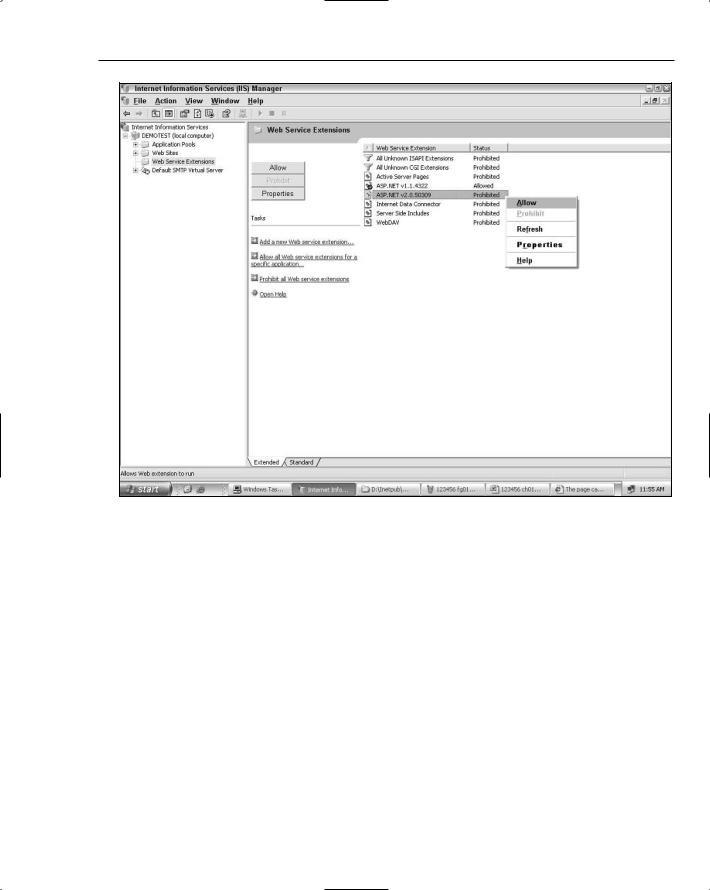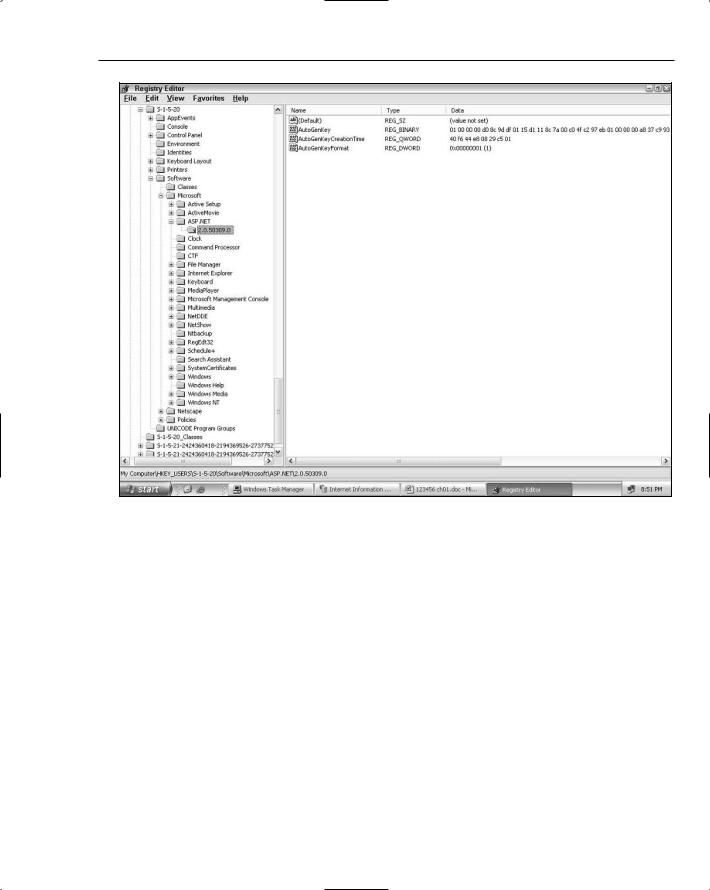
Asp Net 2.0 Security Membership And Role Management
.pdf
Chapter 1
When IIS receives a request for a file, if the file extension for that request is mapped to an ISAPI extension, IIS routes the request to the mapped ISAPI extension instead of consulting the list of MIME types and serving the file as static content. In the case of the .aspx file extension, the request is routed to aspnet_isapi.dll, which contains the code that bootstraps the ASP.NET runtime and allows ASP.NET pages to run.
If you scroll around a bit through the various application extensions, you can see that there are a large number of mapped extensions. Clicking the Executable Path column sorts the extensions and makes it easier to see which file extensions are currently mapped to the ASP.NET ISAPI extension. Most of the extensions that start with the letter a should be familiar to varying degrees (everyone who writes HTTP handlers raise your hand!). Several other file extensions are probably familiar to you from working with tools like Visual Studio or SQL Server, but it may not make sense why these file extensions are now mapped to the ASP.NET ISAPI extension.
For example, the various Visual Studio project extensions (.csproj, .vbproj) are mapped to aspnet_isapi.dll. Simiarly, SQL Server database extensions (.ldf and .mdf) are mapped to aspnet_isapi.dll. From experience though, you know that your ASP.NET web servers have not been processing project files or opening database files and pretending to be a database engine.
This leads to another approach of using ISAPI extensions. Not only do ISAPI extensions parse and process files that are mapped to them, but ISAPI extensions can also be configured to handle other file types for specific purposes. When ASP.NET is installed, file extensions for files that commonly occur within a developer’s ASP.NET project are mapped to the ASP.NET ISAPI extension. Because XCOPY deployment is an easy way to move an ASP.NET application from a developer’s desktop onto a web server, there can be a number of files within the structure of an ASP.NET project that the developer does not want served to the Internet at large. By mapping these file extensions to aspnet_isapi.dll, IIS will pass requests for these file types to the ASP.NET runtime. Because ASP.NET has a parallel configuration system that maps file extensions to specific processing logic (.aspx pages are executed by the ASP.NET page handler), ASP.NET can choose to do something other than executing the requested file. In the case of file extensions like .csproj or .mdf, ASP.NET has a special handler that will deny access to files of this type and return an error to that effect. This technique will be revisited later in the chapter when the default handler mappings for ASP.NET are discussed.
Throughout this discussion there has been the implicit assumption that after a mapping between a file extension and an ISAPI extension is established, dynamic content will start working. Although this was the case for IIS5 and IIS5.1, IIS6 introduced an extra layer of protection around ISAPI extensions. On IIS6, an administrator must take some kind of explicit action to allow an ISAPI extension to operate. If IIS6 is installed on a Windows Server 2003 machine in its most basic configuration, even though ASP.NET bits exist on the machine, requests to .aspx pages will always fail with a 404 error.
The reason for this is that IIS6 has the ability to enable and disable individual ISAPI extension DLLs. If you use the Manage Your Server Wizard in Windows Server 2003, it will automatically reenable the ASP.NET1.1 ISAPI extension for you when you configure the server in the Application Server role. As a result, when the 2.0 version of the framework is installed on top of it, the ASP.NET 2.0 ISAPI extension will be enabled as well.
However, if you install the 2.0 version of the framework but are still receiving 404 errors, you need to enable the ASP.NET ISAPI extension. Figure 1-5 shows the Web Service Extensions configuration window in the IIS MMC. Right-click the ASP.NET extension to access the option to enable the extension.
12

Initial Phases of a Web Request
Figure 1-5
Aside from causing premature gray hair for developers and administrators wondering why a perfectly good ASP.NET application is dead in the water, the ISAPI extension lockdown capability does serve two useful purposes:
If the web server is not intended to ever serve dynamic ASP.NET content, disabling ISAPI extensions is an easy and effective way to lock down the server.
With the release of ASP.NET 2.0, you can use this feature to disable the ASP.NET 1.1 ISAPI extension. For example, if you want to ensure that only ASP.NET 2.0 applications are deployed onto a specific web server, you can disable the ASP.NET 1.1 extension on that server.
Wildcard Application Mappings
IIS6 introduced the concept of wildcard application mappings. With IIS5/5.1, customers were asking for the ability to map all requests for content to a specific ISAPI extension. However, the only way to accomplish this prior to IIS6 was to laboriously map each and every file extension to the desired ISAPI extension. Also, after the request was routed to the ISAPI extension, the ISAPI extension was responsible for completing the request. There was no mechanism for passing the request to other ISAPI extensions or back to IIS.
13

Chapter 1
With IIS6, it is now possible to set up rules (aka wildcard application maps) that route all HTTP requests to one or more ISAPI extensions. The set of wildcard application mappings can be prioritized, so it is possible to have a chain of wildcard mappings. IIS6 also includes a new API for ISAPI extensions to route a request out of an extension and back to IIS6. The net result is that with IIS6 and ASP.NET 2.0, it is possible to have a request for a static file flow through the first portion of the ASP.NET pipeline, and then have the request returned to IIS6, which subsequently serves the file from the file system.
Out of the box though, ASP.NET 2.0 does not configure or use any wildcard application mappings. ASP.NET 2.0 does include though the necessary internal changes required to flow a request back out to IIS6. As a result, ASP.NET 2.0 has this latent ability to integrate with and use wildcard application mappings for some very interesting scenarios. As mentioned earlier, it is possible for an ISAPI extension to perform some processing for a requested file without actually understanding the requested file format. An interesting new avenue for integrating ASP.NET 2.0 with static files and legacy ASP code is discussed later in this book in Chapter 6, “Integrating ASP.NET Security with Classic ASP,” The techniques in that chapter depend on the wildcard application mapping functionality of IIS6.
aspnet_isapi.dll
After a request reaches aspnet_isapi.dll ASP.NET takes over responsibility for the request. IIS6 itself knows nothing about managed code or the .NET Framework. On the other hand, the core processing classes in ASP.NET (HttpApplication and the specific handlers that run .aspx pages, .asmx Web Services, and so on) do not possess the ability to reach out and directly consume an HTTP request. Although the vast majority of ASP.NET is managed code, the ISAPI extension plays a critical role in bridging the native and managed code worlds.
The responsibilities of the ISAPI extension fall into two broad areas:
Starting up an application domain so that managed code associated with an application can run
Setting up the security context for each request and then passing control over to the managed portion of ASP.NET
Understanding some of the important portions of application domain startup is important for later discussions on trust levels and configuration. Information about the per-request initializations and handoff will be covered in Chapter 2.
ASP.NET includes several classes in the System.Web.Hosting namespace that can be used by applications that want to host ASP.NET. If you use the file-based web project option in Visual Studio 2005, you are using a standalone executable (WebDev.WebServer.exe located in the framework install directory) to host ASP.NET. Also, if you search on the Internet several articles and sources demonstrate how to write console and Winforms applications to host ASP.NET. However, most ASP.NET developers are writing web applications and expect their applications to be hosted on a web server. As a result, you can think of aspnet_isapi.dll and its supporting managed classes as the default implementation of an ASP.NET host.
14

Initial Phases of a Web Request
Starting Up an Application Domain
All managed code in the .NET Framework needs to run within an application domain. Before ASP.NET can start the HTTP pipeline and run a page, the ISAPI extension must ensure that an application domain has been instantiated and initialized. In ASP.NET, each application, as configured in the IIS MMC, maps to a separate application domain in the managed world. Figure 1-6 shows a web server with a default website, and one IIS application configured beneath the root of the default website.
Figure 1-6
The ASP.NET ISAPI extension will ensure that an application domain is created for ASP.NET during the first request for a page in the default website. If another request were received for a page within the web application called inproc, aspnet_isapi.dll would create a second application domain because inproc is configured as a separate application. Overall, this means that within a single IIS6 worker process, any number of configured IIS applications, and thus independent application domains, can be running. It is the responsibility of the ISAPI extension to route each incoming HTTP request to the appropriate application domain. Isolating the different applications into separate application domains gives ASP.NET the flexibility to perform some of the following tasks:
Maintain separate security configurations for each application domain
Enforce different trust level restrictions in each application domain
Monitor and if necessary recycle application domains without affecting other application domains
Starting up an application domain involves several processing steps. After a new application domain has been created, the ISAPI extension carries out the following steps, listed in order of their occurrence:
1.
2.
3.
4.
5.
6.
Establish the identity for application domain initialization.
Verify directory access/existence and initializing directory information.
Set the trust level for the application domain.
Set the locations of assemblies.
Obtain the auto-generated machine key.
Initialize the ASP.NET compilation system.
15

Chapter 1
Establishing Identity
Prior to the ISAPI extension performing any other initialization work, it ensures that the correct security identity is established. The identity used for initialization is one of the following:
1.If the application is running from a local disk, and there is no <identity /> tag with an application impersonation identity, then the identity of the worker process is used. Under IIS6 this would be NT AUTHORITY\NETWORK SERVICE. On older versions of IIS, the identity would the local ASPNET machine account. Even if the current thread is running with other security credentials established by IIS, the ISAPI extension will temporarily revert to using the process identity.
2.If the application has an <identity /> tag that enables impersonation, and there is an explicit username and password configured (usually referred to as application impersonation), then initialization will run as the application impersonation identity. ASP.NET will attempt to create a security token for this identity, calling LogonUser in sequence for each of the following logon types until a logon succeeds: BATCH, SERVICE, INTERACTIVE, NETWORK_CLEARTEXT, and
NETWORK.
3.If the application was configured to run off of a UNC share, and there is no application impersonation identity, initialization will run with the configured UNC credentials.
Initializing Directory Information
An ASP.NET application depends on a number of directories for the application to execute properly. The extension will first ensure that the physical application directory exists. If the application directory does not actually exist, or if the current security identity does not have read access to the application directory, the extension returns an error stating that the server could not access the application directory.
Next, ASP.NET initializes the application-relative data directory information. In the v2.0 of the Framework, ADO.NET supports the ability for applications to set application-relative path information to a data file. This allows applications, such as ASP.NET applications, to deploy SQL Server files in an application-rela- tive location (the App_Data directory). The application can then reference the database using a standard connection string syntax that does not change even when the underlying file structure is moved. For all of this magic to work though, ASP.NET must set an application domain variable, DataDirectory, with the proper physical path information so that ADO.NET can correctly resolve relative directories in connection strings. As part of application domain startup, ASP.NET determines the full physical path to the data directory and stores it in the DataDirectory application domain variable.
Any code can query an application domain and retrieve this application domain variable just by calling
AppDomain.CurrentDomain.GetData(“DataDirectory”). Because storing physical paths could lead to an information disclosure, ASP.NET also tells the framework to demand FileIOPermissionAccess
.PathDiscovery from any callers. In practice, this means any ASP.NET application running at Low trust or higher can inspect this variable (trust levels and how they work are covered in Chapter3, “A Matter of Trust.”)
The last major piece of directory related initialization involves the code generation directories used by ASP.NET. Most ASP.NET applications cannot generate page output based solely on .aspx pages that are deployed to a web server. ASP.NET usually has to take additional steps to auto-generate classes (page classes, user control classes, and so on) that are derived from the classes a developer works with in codebehind files. In ASP.NET 2.0 there is a wide array of other auto-generated and auto-compiled artifacts
16

Initial Phases of a Web Request
beyond just page classes. For example, ASP.NET 2.0 dynamically generates a class definition based on the <profile /> configuration element and then compiles the resulting class definition. For all these types of activities, ASP.NET needs a default location for generated code as well as the compiled results of the auto-generated code.
By default, during application domain initialization, ASP.NET will attempt to create an application specific code-generation (or codegen for short) directory structure at the following location:
%windir%\Microsoft.NET\Framework\v2.0.50727\Temporary ASP.NET Files\appname
As noted earlier, your Windows path will vary, and the final shipping version of the framework will have a different version number. The final portion of this directory path will reflect the name of the ASP.NET application.
By default, when the framework is installed, the local machine group IIS_WPG, the local machine account ASPNET, and the NT AUTHORITY\NETWORK SERVICE accounts are granted read and write access (in addition to other security rights) to this temporary directory. As a result, the current security identity normally has rights to create an application specific code-generation directory. If the current security identity does not have read and write access to the Temporary ASP.NET Files directory, then ASP.NET will return an exception to that effect.
If you are running ASP.NET as an interactive user, ASP.NET will fall back and use the operating system’s temporary directory as the root beneath which it will create code-generation directories. On Windows Server 2003, the temporary directory structure is rooted at %windir%\TEMP. You will likely encounter this situation if a developer uses a file-based web while developing in Visual Studio 2005. File-based webs use the standalone Cassini web server for running ASP.NET applications and Cassini runs as the current interactive user. If the interactive user does not have read and write access to the Temporary ASP.NET Files directory (for example the interactive user is not a machine administrator or a member of Power Users), then the operating system’s temporary directory structure would be used instead. Again though, this fallback behavior is limited to only the case where the ASP.NET host is running as an interactive user. On most production web servers, this will never be the case.
Setting the Trust Level
As a quick recap of code access security (CAS) concepts, remember that the .NET Framework can use four levels of code access security policies:
1.
2.
3.
4.
Enterprise
Machine
User
Application domain
The first three levels of CAS policy can be configured and maintained by administrators to ensure a consistent set of CAS restrictions. However, an administrator normally has no ability to configure or enforce application domain CAS restrictions.
ASP.NET 1.1 introduced the concept of trust levels and exposed a configuration element (<trust />) as well as Extensible Markup Language (XML) text files that contain the actual definitions of various ASP.NET trust levels. Later in the book in Chapter 3 the specifics of the ASP.NET trust level settings will
17

Chapter 1
be discussed in more detail. However, trust levels are introduced at this point of the discussion because application domain initialization is where ASP.NET loads and applies the appropriate trust level information. After you understand how ASP.NET trust levels work, the knowledge that an ASP.NET trust level is converted into and applied as an application domain policy very early in the lifetime of an application domain helps to explain some of the more obscure security errors customers may encounter.
In practice, many folks are probably unaware of ASP.NET’s ability to apply an application domain policy, and instead their websites run in full trust. Partly this is due to the fact that both ASP.NET 1.1 and ASP.NET 2.0 set the ASP.NET trust level to full by default. Full trust means that the .NET Framework allows user-authored code the freedom to call any API without any security restrictions.
After ensuring that the required directories are available, ASP.NET checks the trust level setting in configuration that is found in the <trust /> configuration section. Based on the configured trust level, ASP.NET loads the appropriate trust policy configuration file from the following directory:
%windir%\Microsoft.NET\Framework\v2.0.50727\CONFIG
The contents of the trust policy file are modified in memory to replace some of the string replacement tokens that are present in the physical policy files. The end result of this processing is a reference to a System.Security.Policy.PolicyLevel instance that represents the desired application domain security policy. ASP.NET then applies the policy level to the application domain by calling
System.AppDomain.CurrentDomain.SetAppDomainPolicy.
This processing is one of the most critical steps taken during application domain initialization because prior to setting the application domain’s security policy, any actions taken by ASP.NET are running in full trust. Because a full trust execution environment effectively allows managed code to call any API (both managed APIs and native APIs), ASP.NET intentionally limits the initialization work it performs prior to setting the application domain’s security policy. Looking back over the initialization work that is completed prior to this step, you can see that ASP.NET has not actually called any user-supplied code up to this point. All of the initializations are internal-only checks and involve only framework code.
With the application domain’s permission policy established though, any subsequent initialization work (and of course all per-request processing) that calls into user-supplied code will be restricted by the application domain policy that ASP.NET has applied based on the contents of a specific ASP.NET trust policy configuration file.
An important side effect from establishing the trust level is that any calls into the configuration system from this point onwards are subject to the security restrictions defined by the trust level. Configuration section handlers are defined in machine.config as well as web.config within the <configSections /> configuration element. By default a number of configuration section handlers are registered in the configuration files.
Because ASP.NET establishes the bin directory as one of the locations for resolving assemblies, it is possible to author configuration section handlers that reside within assemblies deployed to the bin directory. Because the application domain CAS policy has been set, any initialization logic that a user-authored configuration section handler executes when it loads is restricted to only those operations defined in the associated ASP.NET trust policy file. For example, in an ASP.NET application that runs at anything other than full trust, user code cannot call into Win32 APIs. As a result, in a partially trusted ASP.NET application, a web server
18

Initial Phases of a Web Request
administrator is guaranteed that a malicious configuration section handler cannot make calls into Win32 APIs that attempt to reformat the hard drive (granted this is an extreme example, but you get the idea).
In Chapter 4 “Configuration System Security” the effects of ASP.NET trust levels on configuration will be discussed in more detail.
Establishing Assembly Locations
With the application domain policy set, ASP.NET performs some housekeeping that allows the .NET Framework assembly resolution to be aware of the bin directory. This allows the .NET Framework assembly resolution logic to probe the bin directory and resolve types from assemblies located within the “bin” directory. Remember that earlier ASP.NET performed some work to set up the code-generation directory structure. A side effect of this setup is that ASP.NET and the .NET Framework also have the ability to resolve types located in the application-specific code-generation directory.
ASP.NET also attempts to enable shadow copying of assemblies from the bin directory. Assuming that shadow copying is enabled, the .NET Framework will make private copies of these assemblies as necessary within the code-generation directory structure for the application. When the .NET Framework needs to reference types and code from assemblies in the bin directory, the framework will instead load information from the shadow copied versions. Shadow copying the bin assemblies allows you to copy new versions of assemblies into the bin directory without requiring the web application to be stopped. Because multiple web applications may be simultaneously running within a single worker process, the shadow copying behavior is important; it preserves the ability to maintain uptime for other web applications. If each application domain maintained a file lock on the assemblies located in the bin directory, XCOPY deployment of an ASP.NET application would be difficult. An administrator would have to cycle the entire worker process to release the file locks. With shadow copying, you can copy just new binaries to the server and ASP.NET will automatically handle shutting down the affected application domain and restarting it to pick up changes to the bin directory.
ASP.NET 2.0 introduces a new configuration element — <hostingEnvironment /> — that administrators can used to disable shadow copying. The following configuration when placed within <system.web /> will disabled shadow copying:
<hostingEnvironment shadowCopyBinAssemblies=”false”/>
You may want to disable shadow copying if an administrator explicitly disallows overwriting assemblies on a production server. Disabling shadow copying would prevent someone from randomly updating an application’s binaries when the application is already up and running. Also some assemblies expect that other files exist on the file system in the same directory structure as the assembly. In these cases, shadow copying causes the assembly to be shadow copied to a completely different directory structure, thus breaking the assembly’s assumptions about relative file locations.
Obtaining the Auto-Generated Machine Key
If you have ever used viewstate or issued a forms authentication ticket, it is likely that you depended on an auto-generated machine key to provide security. The default <machineKey /> configuration for an ASP.NET application sets both the validationKey and decryptionKey attributes to AutoGenerate,IsolateApps. During application domain initialization, ASP.NET ensures that the auto-generated machine key is available so that ASP.NET applications that depend on automatically generated keys will have the necessary key material.
19

Chapter 1
The actual logic for generating and confirming the existence of the auto-generated machine key has changed over various versions of ASP.NET and with the different process models for hosting ASP.NET inside of IIS. Originally, when only Windows 2000 was available, the ASP.NET ISAPI extension would always run as SYSTEM because in IIS5 (and for that matter IIS 5.1), ISAPI filters and extensions always ran with the security credentials of the inetinfo.exe process. As a result, for IIS 5 and IIS 5.1, the ISAPI extension checks for the existence of the machine-generated key inside of the Local Security Authority (LSA). Because SYSTEM is such a highly privileged account, the ISAPI extension could safely generate and store the auto-generated machine key in the LSA.
However, with the process model in IIS6, ISAPI filters and extensions execute in a specific worker process. By default, the w3wp.exe worker process runs as NETWORK SERVICE, which has much fewer privileges than SYSTEM. As a result, the approach of storing items in LSA no longer works because NETWORK SERVICE does not have permission to read and write the LSA. Trust me when I say that this is a good thing (the idea of having your web server happily stuffing secret keys into the LSA is a little bit odd to say the least).
In IIS6, when running as NETWORK SERVICE the ASP.NET2.0 ISAPI extension will store and retrieve the auto-generated machine key from the following location in the Registry:
HKU\SID\Software\Microsoft\ASP.NET\2.0.50727.0
The value for the security identifier (SID) will vary depending on the identity of the worker process account. By default though when an IIS6 worker process runs as NETWORK SERVICE the SID will be S-1-5-20. Underneath this key are three values:
AutoGenKey — This is the auto-generated machine key that is used for encryption and validation by forms authentication and for viewstate.
AutoGenKeyCreationTime — An encoded representation of the file time when the key was generated.
AutoGenKeyFormat — Indicates whether the auto-generated machine key was stored in an encrypted form (1) or as cleartext (2).
The very first time the ISAPI extension attempts to retrieve the auto-generated machine key, ASP.NET creates a random value, encrypts it using DPAPI (the extension uses the DPAPI user store), and stores the resultant information under the HKCU key mentioned earlier. In Figure 1-7, the auto-generated machine key information is stored in the user hive for NETWORK SERVICE. The SID S-1-5-20 is the common SID representation for NETWORK SERVICE.
However, the question arises as to how the ISAPI extension can obtain an auto-generated machine key if the ASP.NET application is running as an account other than NETWORK SERVICE. For example, in IIS6 administrators commonly change the worker process identity to that of a local machine account or a domain account. Also, some web applications will use the <identity /> element to configure a specific application impersonation identity.
20

Initial Phases of a Web Request
Figure 1-7
Although NETWORK SERVICE can store and retrieve the auto-generated machine key inside of the HKEY_USERS (HKU) area of the Registry, this technique will not work for local or domain accounts because accessing HKU requires that a user profile be loaded. Loading a user profile includes loading the portion of the Registry hive that is unique to a specific user. However, with IIS6 and ASP.NET, the user profile is loaded under only the following scenarios:
The worker process is running as either NETWORK SERVICE or as LOCAL SERVICE.
IIS6 is running in IIS5 isolation mode, in which case the user profile for the local ASPNET machine account will be loaded.
Other local and domain accounts will not have a user profile loaded on their behalf. As a result, ASP.NET needs some other location for storing the auto-generated machine key. If you choose to run ASP.NET with either a local or domain machine account, always make sure to run the following command line from the framework installation directory:
aspnet_regiis -ga DOMAIN\USERNAME
21
